Even after two centuries, many structures in Mamallapuram give us a sense of how the town is still evolving. C Gangadharan Menon discovers the amalgamation of the Pallava and Chola architecture here which makes this place unique
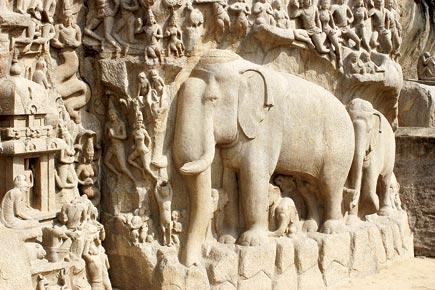
The stones that came to life at the hands of the Pallava sculptors here have been breathing for the last 1,500 years. And the stones that have just been given life by their descendants will breathe for many centuries to come. That’s the living tradition of an artistic land called Mamallapuram in Chennai.
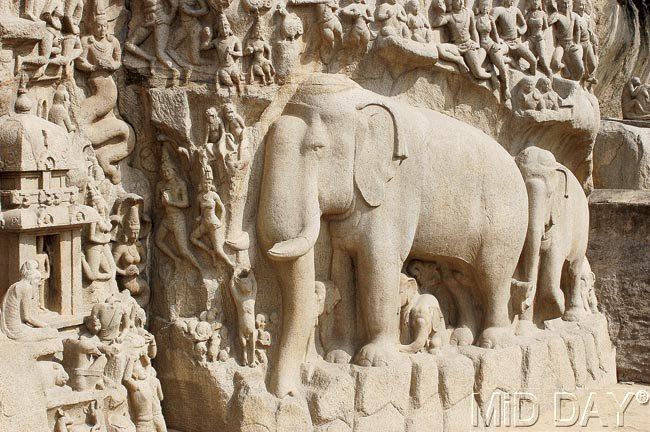
The world’s largest bas-relief sculpture measuring 100 feet by 40 feet has Arjuna standing on one leg and doing penance in Kailas. Pics/ C Gangadharan Menon
ADVERTISEMENT
The whole village is a World Heritage Site, with an area of eight sq kms and a miniscule population of less than 8,000. Around 200 of them carry forward the magical tradition of sculpting. In many houses, you can find three generations of sculptors chiselling under one roof.
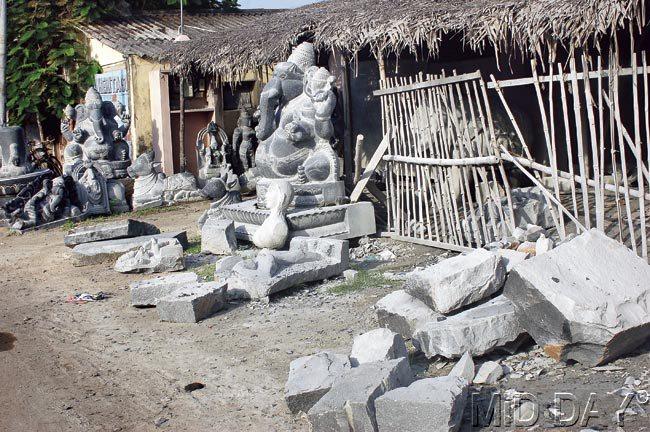
The open-air studio where three generations of sculptors have carved stone
It was at the sanctum sanctorum of the Shore Temple that I meet my guide. His name is CK Prasad, and he looks the most unlikely candidate for the job. He is well-dressed to a fault, and has a quiet presence that only comes with intense introspection. He is a retired civil engineer who lives in Chennai, and travels 60 km every day only because he is in love with Mamallapuram.
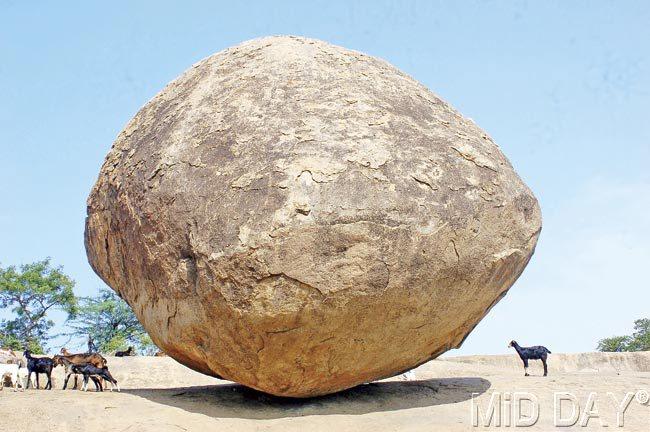 Krishna’s Butter Ball is placed on a slope in such a way that it looks like a gentle push could topple the boulder
Krishna’s Butter Ball is placed on a slope in such a way that it looks like a gentle push could topple the boulder
He doesn’t have a fixed rate for his service and is happy with anything that I give him, he says, because he will do it for free anyway! Later I realise that he is an encyclopaedia of Pallava art and history, and I wonder whether he is a descendant of a Mamalla king.
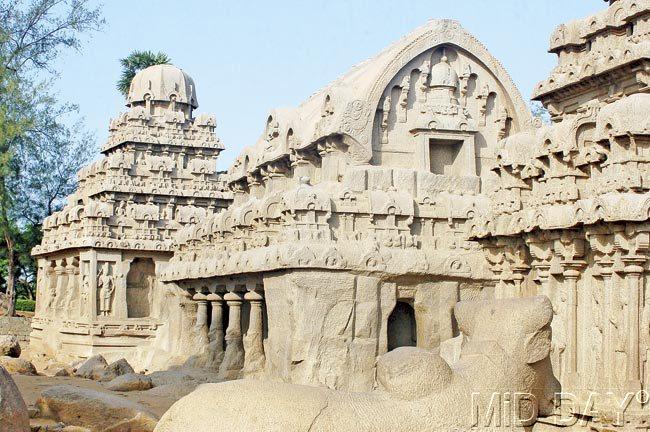
Temples of Five Rathas are five temples in the shape of five chariots, built in different architectural styles
A sacred land
The Shore Temple was excavated by the British from golden sands of Mamallapuram in the 1900s, but it went under the sand again during the tsunami of 2004. After the second excavation, 80 guardian Nandis have been lined up to form a protective ring around the sacred shivling here.
A unique feature of this temple is that the shivling is so strategically placed that it is bathed in a golden sunlight, both at sunrise and sunset. It is considered to be the very first example of the evolved Dravidian style of architecture.
Interestingly, of all the temples in Mamallapuram, there’s only the Vishnu temple that lives in the heart of the village. The others are all just architectural monuments: some rock-cut, some monolithic. The most spectacular of the monolithic ones is Five Rathas.
These are five temples in the shape of five chariots, each one carved in a different architectural style. Though they are named after the Pandavas, the deities inside are Vishnu, Shiva, Durga, Indra and Surya.
I move on to an amazing cave with two dramatically opposite scenes carved on either side: to the left is the gruesome scene of Durga slaying Mahishasura, and on the right is the tranquil, cosmic Vishnu reclining on the serpent Shesh Nag.
To the right of the cave house of the Pallavas is the world’s largest bas-relief sculpture measuring 100 x 40 feet, where the main visual is Arjuna standing on one leg and doing penance in Kailas. The natural fissure in this boulder has been incorporated into the sculpture itself.
During the monsoon, the gushing water that flows through the fissure looks like River Ganga descending from Kailas to Earth. To the north of this man-made marvel is a marvel of nature. A huge boulder that is 35 feet tall is so precariously placed on a slope that it looks like it could be toppled by a gentle push.
But village folklore has it that all the king’s horses and all the king’s men could not move it an inch. This humongous inedible rock is called Krishna’s Butter Ball. On the Mahabalipuram-Chennai highway, four km from other structures is the Tiger’s Cave. This is an open-air theatre, and the stage is lodged right inside the mouth of a sculpted tiger!
The many incomplete structures here show that Mamallapuram is still work-in-progress even after two centuries of chiselling. And the work couldn’t be completed because the Cholas later captured the kingdom.
When the dust of the battle settled, a new style emerged that was a blend of the Pallava and the Chola style. Legend has it that once a sthapathi or a master sculptor in Mamallapuram created an idol so full of life that when the chisel fell on the diety’s hand, the hand started bleeding.
Cholamandal Artists’ village
When the Pallavas were vanquished by the Cholas, the art too underwent a metamorphosis. The robust Pallava style was tempered by a more lyrical Chola style, the epitome of which is seen in the sculpture of the dancing Nataraja.
Inspired KCS Paniker, a pioneer in modern Indian art, established Cholamandal Artists’ Village between Mamallapuram and Chennai on the East Coast. The idea was to have a community of artists living and working in the same place.
The result was a style that was an amalgamation of imagery from tantra, motifs from yantra, mathematical symbols, Indian mythology, and Indian calligraphy. All of which was witnessed in the Madras Art Movement for the very first time in Indian paintings.
When I walk into this idyllic art world, I am greeted by an affable lady who takes me around, first to KCS Paniker Museum of the Madras Art Movement, and then to the two adjoining art galleries. But the open-air international sculpture park is a unique experience.
As I drive back to Chennai, I wonder whether it is the traditional stone sculptures that are inspired by the Pallava artisans or the contemporary sculptures that are inspired by Chola artists, every stone in Mamallapuram has a life of its own.
 Subscribe today by clicking the link and stay updated with the latest news!" Click here!
Subscribe today by clicking the link and stay updated with the latest news!" Click here!







